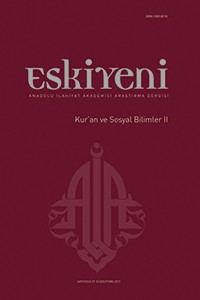Öz
Bu çalışmada iletişimde etkin bir araç olarak “susma”nın konuşma veya
yazmaya kıyasla azımsanmayacak bir öneme sahip olduğu hususuna ışık tutulmaya
çalışılmıştır. Çalışmada dilin bir iletişim aracı olarak mesajı aktarmada zaman
zaman ne derecede başarısız olduğu da gösterilmektedir. Bu açıdan bakıldığında
“susma” dilin önemli ve tamamlayıcı bir seçeneği olarak kabul edilebilir.
Anahtar Kelimeler
Kaynakça
- Bruneau, J.J. (1973) Communicative Silences: Forms and Functions, Journal of Communication, 32 (1), pp.17-46.
- Brown, P. and S. Levinson (1987) Politeness: Some Universals in Language Usage, Cambridge :CUP.
- Chomsky, N. (1957) Syntactic Structure, The Hague: Mouton and co.
- Chomsky, N (1979) On Cognitive Structure and Development: A Reply to Piaget, Massioni Palmarini (ed.), Language and Learning, pp. 35-52.
- Davanizhad, K. (2009) Cross-Cultural Communication and Translation, Translation Journal, 13 (4), pp.1-10.
- Ephratt , Michal (2008) The Function of Silence, Journal of Pragmatics, 40, pp. 1909-1938.
- Erkman, P. (1976) Movements with Precise Meanings, Journal of Communication, 26, pp. 14-16.
- Erton,I.(2006) Semiotic Nature of Language Teaching Methods in Foreign language Learning and Teaching, Journal of Language and Linguistic Studies, vol.2,No1 pp.73-86.
- Jacobson, R.(1974) Main Trends in the Science of Language, New York: Harper.
- Jawrski, Adam (1993) The Power of Silence: Social and Pragmatic Perspectives, Sage Publications, Newbury Park, CA.
- Khalil, Aziz M: A Contrastive Grammar of English and Arabic, The Jordan Book Center, Amman, 2010.
- Kristeva, J. (1986) The Kristeva Reader, Oxford: Basil Blackwell Ltd.
- Lebra, T. (1987) The Cultural Significance of Silence in Japanese Communication, Multilingual 6 (4): 343-57.
- Miller, Roy (1982) Japan Modern Myth,: The Language and Beyond, Tokyo: John Wetherill Inc.
- Nankane, L. (2003) Silence in Japanese – Australian Classroom Interaction: Receptions and Performance, University of Sydney, Sydney.
- Saussure, Ferdinand de (1913) Course in General Linguistics, London: Fontana
- Sert, Olcay (2006) Semiotic Approach and its Contribution to English Language Learning and Teaching, Hacettepe Universitesi Eğitim Fakültesi, Dergisi, 31, pp 106-114.
- Sultan, Sabbar S.(2007) Silence and its Discontents in Literature, Darasat, 34 (3).
Öz
In
this paper it is aimed to shed light on the significance of silence as an
effective tool in communication that is no less powerful than speech or
writing. The attempt was also made to show how language sometimes fails as a
means of communication in conveying the message. Silence, therefore, could be
regarded as an important and complementary alternative for language.
Anahtar Kelimeler
Silence communicative silence silence and culture silence and politeness
Kaynakça
- Bruneau, J.J. (1973) Communicative Silences: Forms and Functions, Journal of Communication, 32 (1), pp.17-46.
- Brown, P. and S. Levinson (1987) Politeness: Some Universals in Language Usage, Cambridge :CUP.
- Chomsky, N. (1957) Syntactic Structure, The Hague: Mouton and co.
- Chomsky, N (1979) On Cognitive Structure and Development: A Reply to Piaget, Massioni Palmarini (ed.), Language and Learning, pp. 35-52.
- Davanizhad, K. (2009) Cross-Cultural Communication and Translation, Translation Journal, 13 (4), pp.1-10.
- Ephratt , Michal (2008) The Function of Silence, Journal of Pragmatics, 40, pp. 1909-1938.
- Erkman, P. (1976) Movements with Precise Meanings, Journal of Communication, 26, pp. 14-16.
- Erton,I.(2006) Semiotic Nature of Language Teaching Methods in Foreign language Learning and Teaching, Journal of Language and Linguistic Studies, vol.2,No1 pp.73-86.
- Jacobson, R.(1974) Main Trends in the Science of Language, New York: Harper.
- Jawrski, Adam (1993) The Power of Silence: Social and Pragmatic Perspectives, Sage Publications, Newbury Park, CA.
- Khalil, Aziz M: A Contrastive Grammar of English and Arabic, The Jordan Book Center, Amman, 2010.
- Kristeva, J. (1986) The Kristeva Reader, Oxford: Basil Blackwell Ltd.
- Lebra, T. (1987) The Cultural Significance of Silence in Japanese Communication, Multilingual 6 (4): 343-57.
- Miller, Roy (1982) Japan Modern Myth,: The Language and Beyond, Tokyo: John Wetherill Inc.
- Nankane, L. (2003) Silence in Japanese – Australian Classroom Interaction: Receptions and Performance, University of Sydney, Sydney.
- Saussure, Ferdinand de (1913) Course in General Linguistics, London: Fontana
- Sert, Olcay (2006) Semiotic Approach and its Contribution to English Language Learning and Teaching, Hacettepe Universitesi Eğitim Fakültesi, Dergisi, 31, pp 106-114.
- Sultan, Sabbar S.(2007) Silence and its Discontents in Literature, Darasat, 34 (3).
Ayrıntılar
| Birincil Dil | İngilizce |
|---|---|
| Konular | Din Araştırmaları |
| Bölüm | Genel Yazılar |
| Yazarlar | |
| Yayımlanma Tarihi | 25 Kasım 2013 |
| Gönderilme Tarihi | 5 Eylül 2013 |
| Yayımlandığı Sayı | Yıl 2013 Sayı: 27 |


